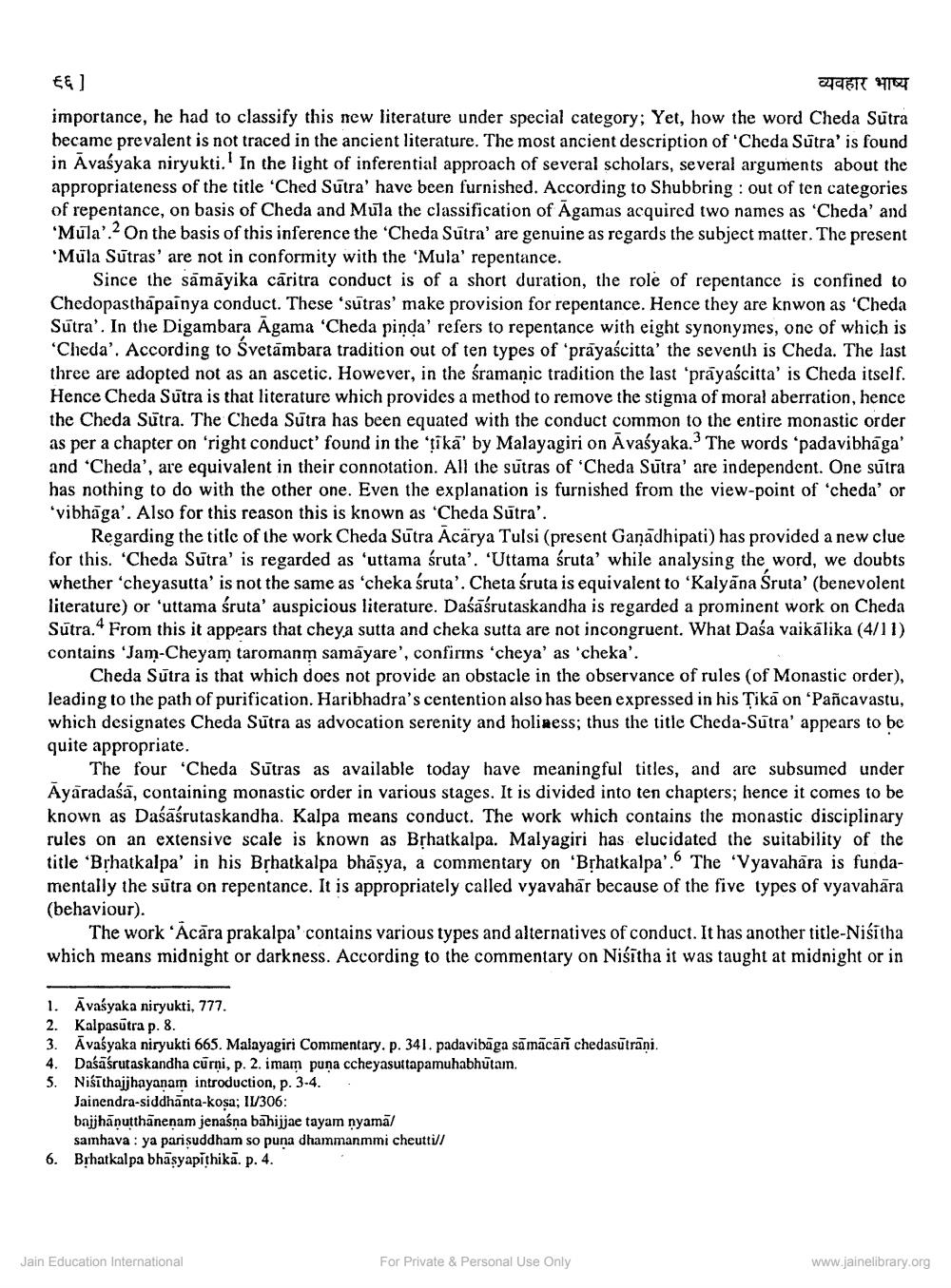________________
EE]
व्यवहार भाष्य importance, he had to classify this new literature under special category; Yet, how the word Cheda Sūtra became prevalent is not traced in the ancient literature. The most ancient description of 'Cheda Sūtra' is found in Avaśyaka niryukti. In the light of inferential approach of several scholars, several arguments about the appropriateness of the title 'Ched Sutra' have been furnished. According to Shubbring : out of ten categories of repentance, on basis of Cheda and Mula the classification of Agamas acquired two names as 'Cheda' and 'Mula'. On the basis of this inference the 'Cheda Sutra' are genuine as regards the subject matter. The present Müla Sutras' are not in conformity with the 'Mula' repentance.
Since the sāmāyika caritra conduct is of a short duration, the role of repentance is confined to Chedopasthāpainya conduct. These 'sūtras' make provision for repentance. Hence they are knwon as 'Cheda Sūtra'. In the Digambara Agama 'Cheda pinda' refers to repentance with eight synonymes, one of which is 'Cheda'. According to Svetāmbara tradition out of ten types of 'prayascitta' the seventh is Cheda. The last three are adopted not as an ascetic. However, in the śramanic tradition the last 'prayascitta' is Cheda itself. Hence Cheda Sutra is that literature which provides a method to remove the stigma of moral aberration, hence the Cheda Sutra. The Cheda Sutra has been equated with the conduct common to the entire monastic order as per a chapter on 'right conduct' found in the 'çika' by Malayagiri on Avaśyaka.? The words ‘padavibhāga' and 'Cheda', are equivalent in their connotation. All the sutras of 'Cheda Sūtra' are independent. One sutra has nothing to do with the other one. Even the explanation is furnished from the view-point of 'cheda' or 'vibhaga'. Also for this reason this is known as 'Cheda Sūtra'.
Regarding the title of the work Cheda Sutra Acarya Tulsi (present Gaņādhipati) has provided a new clue for this. 'Cheda Sutra' is regarded as 'uttama śruta'. 'Uttama śruta' while analysing the word, we doubts whether 'cheyasutta' is not the same as 'cheka śruta'. Cheta śruta is equivalent to 'Kalyāna śruta' (benevolent literature) or 'uttama śruta auspicious literature. Daśāśrutaskandha is regarded a prominent work on Cheda Sutra. From this it appears that cheya sutta and cheka sutta are not incongruent. What Dasa vaikälika (4/11) contains 'Jam-Cheyam taromanm samayare', confirms 'cheya' as 'cheka'.
Cheda Sutra is that which does not provide an obstacle in the observance of rules (of Monastic order), leading to the path of purification. Haribhadra's centention also has been expressed in his Tika on 'Pancavastu, which designates Cheda Sutra as advocation serenity and holiness; thus the title Cheda-Sutra' appears to be quite appropriate.
The four 'Cheda Sutras as available today have meaningful titles, and are subsumed under Ayāradaśa, containing monastic order in various stages. It is divided into ten chapters; hence it comes to be known as Dasasrutaskandha. Kalpa means conduct. The work which contains the monastic disciplinary rules on an extensive scale is known as Brhatkalpa. Malyagiri has elucidated the suitability of the title 'Brhatkalpa' in his Brhatkalpa bhāsya, a commentary on 'Bịhatkalpa'. The 'Vyavahāra is fundamentally the sutra on repentance. It is appropriately called vyavahār because of the five types of vyavahāra (behaviour).
The work 'Acara prakalpa' contains various types and alternatives of conduct. It has another title-Niśitha which means midnight or darkness. According to the commentary on Niśītha it was taught at midnight or in
1. Avaśyaka niryukti, 777. 2. Kalpasútra p. 8. 3. Āvaśyaka niryukti 665. Malayagiri Commentary. p. 341. padavibāga sa mācāri chedasutrani. 4. Daśāśrutaskandha cūrni, p. 2. imam puna ccheyasuttapamuhabhūtam. 5. Nisīthajjhayanam introduction, p. 3-4. .
Jainendra-siddhānta-kosa; 11/306: bajjhānutthanenam jenaśna bahijjae tayam nyamā/
samhava : ya parisuddham so puna dhammanmmi cheutti/ 6. Brhatkal pa bhāsyapithikā. p. 4.
Jain Education International
For Private & Personal Use Only
www.jainelibrary.org




